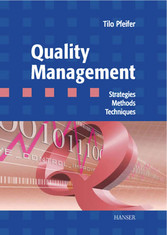Tilo Pfeifer
Quality Management
7.2 Planning product characteristics
Growing prosperity on one hand and the transition from a consumers’ to a global buyers’ market have pushed the quality of goods as a sales argument to the forefront (Fig. 7.2-1). It is clear that buyers no longer seek merely to satisfy basic requirements, but to fulfill their own personal aspirations in the purchase of a product. Companies can therefore only survive global competition if they can produce innovative, high-quality products [pf6]. The quality of a product must be seen as the fulfillment of all of the requirements relating to a product, which potential customers may or may not purchase. The primary function of quality planning – and of quality management in general – must therefore be to ensure that the product meets the customers’ requirement profile as fully as possible. According to [gav], quality requirements can relate to seven different categories of product characteristics (Fig. 7.2-2).
“Fitness for use” describes the central functional characteristic of the product. In the case of a car, this would be transport with characteristics such as travel speed or fuel consumption. In the service sector, e.g. an airline, fitness for use relates to characteristics such as capacity and punctuality. This category of quality has measurable characteristics. Products in one performance class can be ranked objectively on the basis of their benefits.
Quality characteristics in the category “accessories” stand for additional benefits that the product offers. In the case of a car, this might be a satellite navigation system whereas in an aircraft it could be greater attention paid to first-class passengers. The border to utilization value is fuzzy. However, accessories offer the customers options and gratify their need for individuality. “Accessories” are therefore very open to highly subjective evaluation by the customer.
“Reliability” reflects the probability that a product will break down within a certain period of time. The characteristic quantity in this case is the interval between the occurrence of two undesirable events (MTBF or mean time between failures).
“Lifetime” describes both technological and economic aspects. The end of the technical lifetime is the point at which the product loses its fitness for use and at which repair, e.g. when a light bulb fails, no longer appears a viable option. Economic life time ends when the user, faced with repair costs, decides to invest in a new product. In this case, “lifetime” and “reliability” are very closely related.
Quality in the category of “conformity” corresponds to the traditional concepts of quality management, as the concurrence or conformity of the product with the specifications (tolerances). Conformity also describes the fluctuations within a set of products. The familiar “Friday afternoon car” is an example of weaknesses with regard to conformity.
The following two categories of product quality are the ones open to the highest level of subjective influence. The first one, namely the aesthetic characteristics of the product – the design, acoustics, taste or smell of a product – is clearly dominated by personal preference. The term “design” has fallen into a certain disrepute in recent years as a result of products that have been optically pleasing, but lacked the corresponding functionality.
Yet product design, in the sense of a function that has assumed a design, is frequently the only characteristic that can be used to distinguish between products which all meet the same technical standards. As such, it is an important quality characteristic. The quality “image” of a product is based on the untested assumption that the quality of a newly introduced product matches at least to the quality of the established products.
The likely lifetime is usually impossible to estimate on the basis of external impressions. The customer cannot make any truly valid statement until the utilization phase of the product has expired. The customer therefore decides on the basis of tangible alternative criteria such as the image of the manufacturer (brand name) or a promise made in an advertising campaign. Opinions about quality, the good reputation of a product or of the manufacturer then become more important than the quality of the product itself.
© 2009-2024 ciando GmbH
 Zu Hanser-Fachbuch.de
Zu Hanser-Fachbuch.de
 Warenkorb
Warenkorb
